If you’re planning a trip to Northern Germany and you want to experience a medieval town that’ll transport you back through time, then you need to plan a day trip to Lüneburg!
Lüneburg is a town of red brick Gothic architecture that rose to prosperity during the Middle Ages thanks to the salt found directly beneath the town. The salt, also known as white gold, was extracted for more than 1,000 years and it shaped the town’s landscape and history, but more on that later.
Lüneburg Travel Guide: Things to Do, See, Eat & Experience in Lüneburg, Germany
In this blog post, we’ll give you some ideas of things to do in Lüneburg on a day trip. We’ll show you where to get the best panoramic views of the old town, we’ll teach you why many of the town’s buildings are slightly crooked, we’ll tell you where to enjoy some hearty German dishes, plus we’ll share plenty of fun activities for your day trip to Lüneburg, Germany!
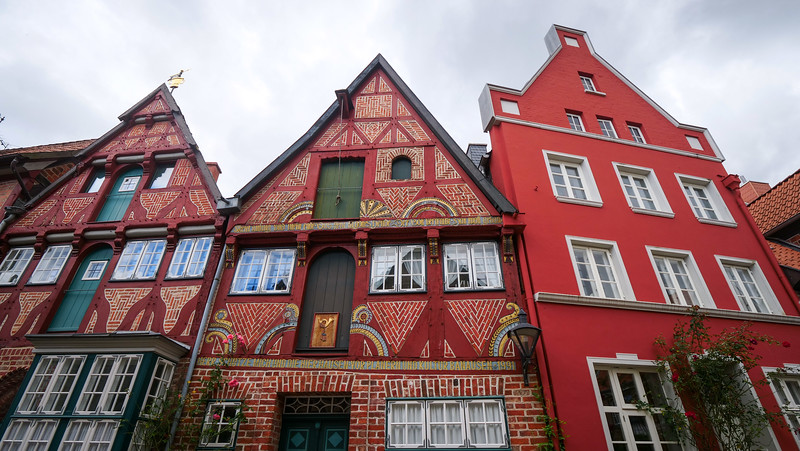
Visiting the town of Lüneburg, Germany
How do you get to Lüneburg?
The best way to get to Lüneburg is by train. It is a 36-minute train ride from Hamburg Hauptbahnhof to Lüneburg on the RE (Regional Express). Or, alternatively, it’s a 1-hour train journey from Hannover on the ICE (Inter City Express).
Can you visit Lüneburg on a day trip?
Lüneburg is situated between Hamburg and Hanover, so it makes for a very easy day trip for anyone travelling around Northern Germany. The town is small enough that visitors can cover most of the tourist attractions in one day. However, for travellers with more time, it’s a great 2-3 day destination.
Is Lüneburg Germany worth visiting?
Yes! If you’re looking for a charming, walkable, medieval town with lots of history, then Lüneburg is worth the visit!
What is Lüneburg known for?
Lüneburg is best known for its salt, which during the Middle Ages allowed the town to rise to prosperity. At the time, salt was in great demand in order to preserve herring caught in the Baltic and North Seas, and Lüneburg’s monopoly on salt production in Northern Europe allowed it to join the Hanseatic League and thrive.
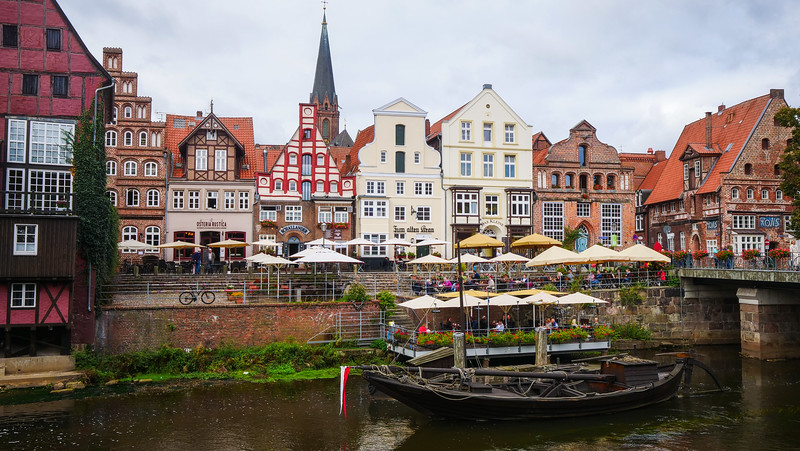
Now let’s talk about some things that you can do in Lüneburg during your one day visit:
Climb the water tower
Our first stop of the day was Wasserturm Lüneburg, or the Lüneburg Water Tower, which is the place to go for panoramic views of the town.
This is a neo-Gothic, red-brick structure situated in the old town and it’s impossible to miss. The tower stands 55 metres tall and it’s the tallest building in Lüneburg’s old town that is not a church. Just wait until you see all the church steeples on the horizon once you reach the top of the tower!
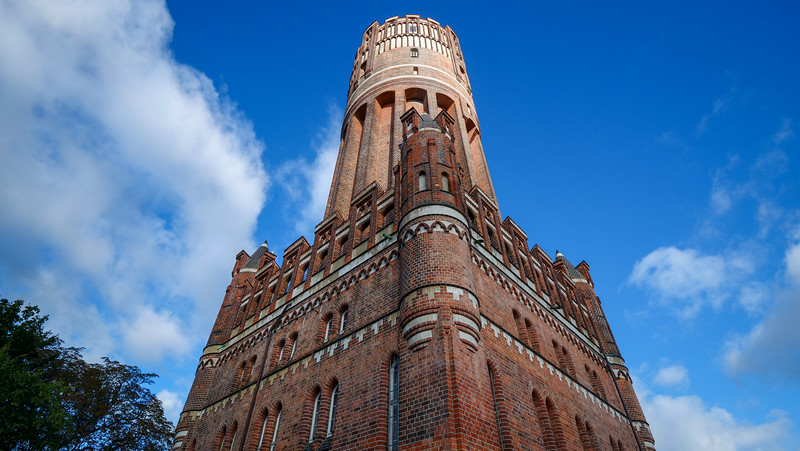
We rode the elevator to the top, but then on the way down, we took the stairs which lead through the old water tank that sits inside the tower. The tank is 500 cubic metres and it was all lit up with blue lights and shifting water patterns – it’s an immersive work of art.
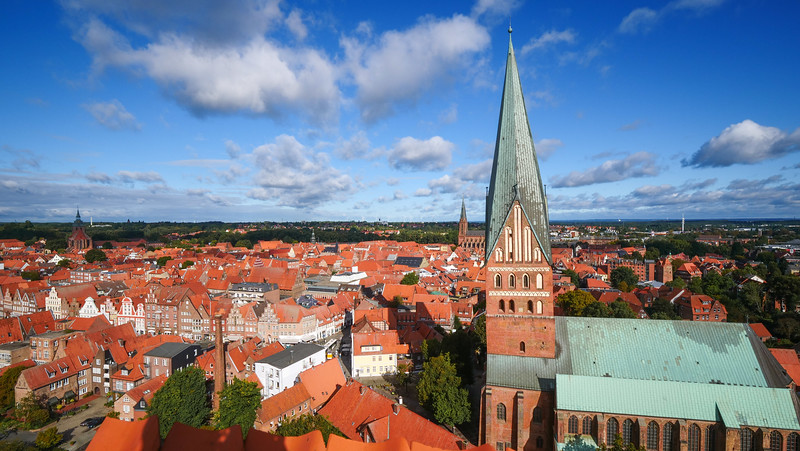


Get lost in the Old Town
We then continued over to Platz am Sande, which is one of the oldest squares in Lüneburg and also one of the most important medieval squares in all of Germany. Medieval trade routes used to run through here so if you were to travel back in time several hundred years, you’d find merchants bringing their goods by cart to trade and haggle in this very spot.
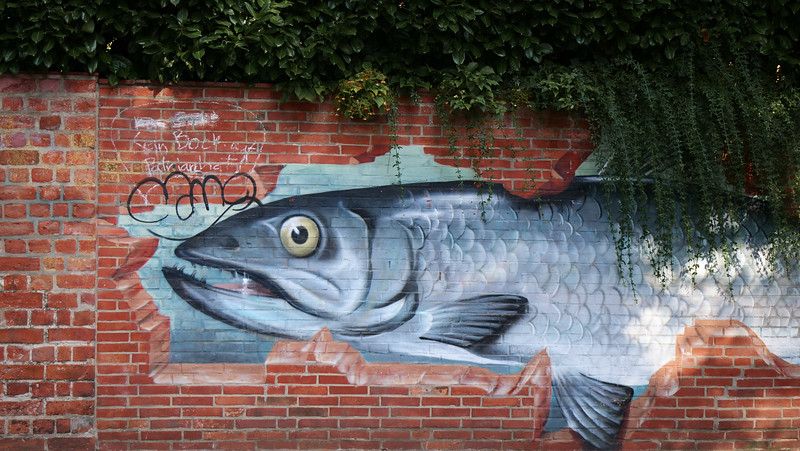
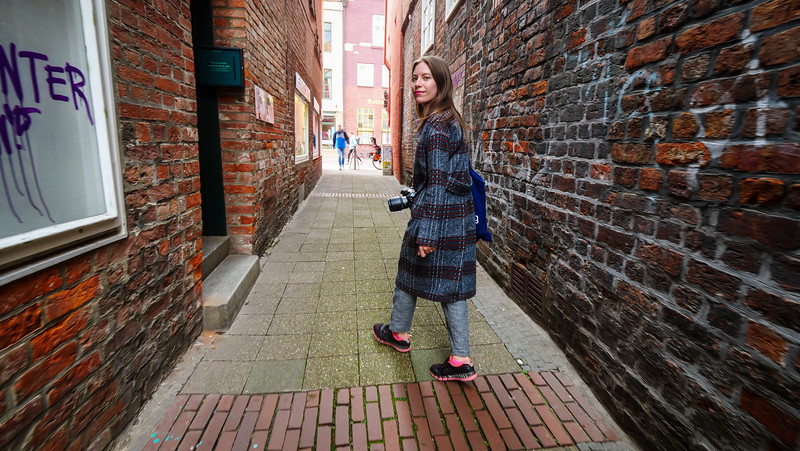
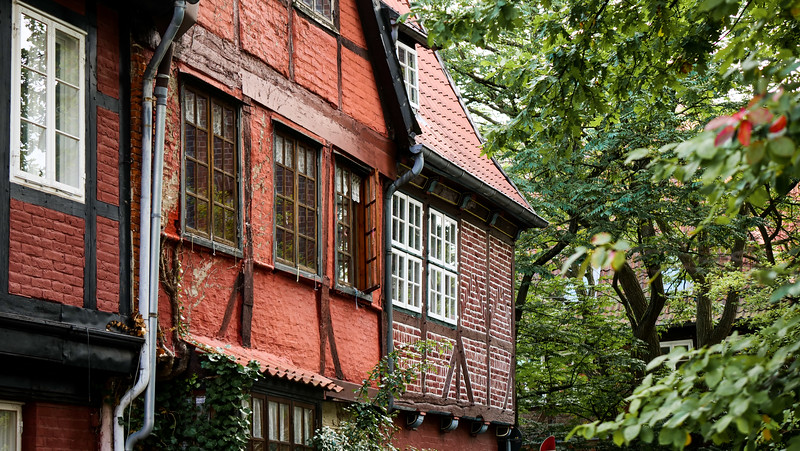
From this point, we started our mapless walk around the old town, going down whatever random streets piqued our interest. It was a very slow walk as we stopped to admire the architectural details of these medieval homes and storefronts that look straight out of a fairy tale.
Visit the main churches
I mentioned earlier that there are a lot of churches in Lüneburg, and we managed to make it to three of the main ones.
Basilica of St Nikolai
The first was the Basilica of St Nikolai, which was built between 1407 and 1440 in the Gothic style. This was the church of the boatmen and salt barrel makers, two very important jobs during the Middle Ages. This is the smallest of the three main churches in Lüneburg, but it’s worth the visit.
Don’t forget to look up at the star rib vault which is a pretty unique design for Northern Germany!
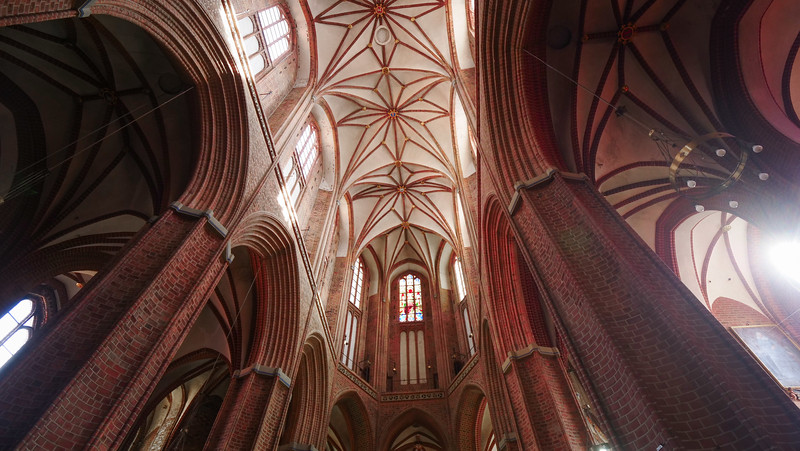
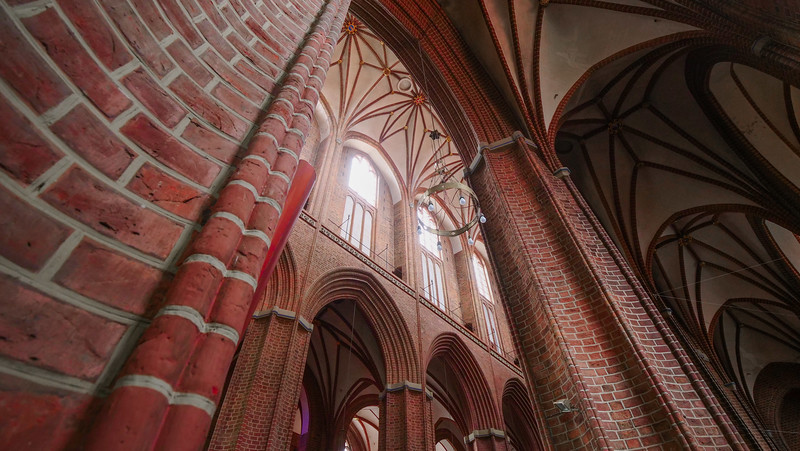
St John’s Church
We also visited Johanniskirche, or St John’s Church, which is the oldest Lutheran church in Lüneburg. What stands about this church is that its 108-meter tower rises crookedly into the sky!
During its construction around the year 1384, the tower was 2.20 meters out of plumb. The thing is, church towers were purposely built slightly crooked into the wind so that they didn’t get the full wind load, but it shouldn’t have been quite so pronounced.
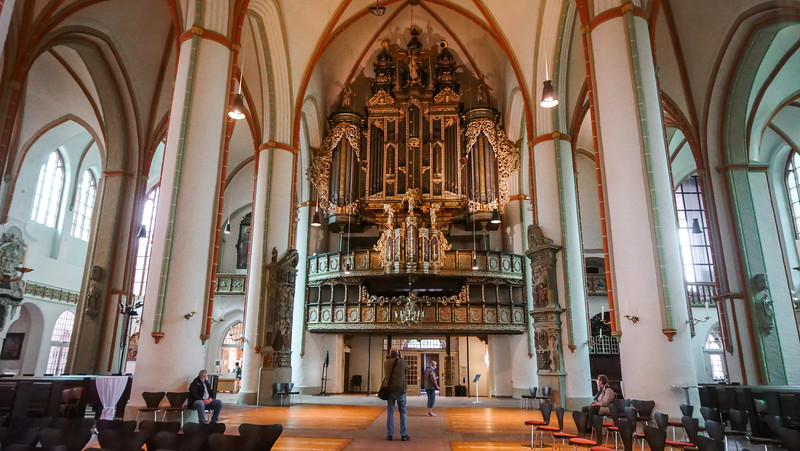
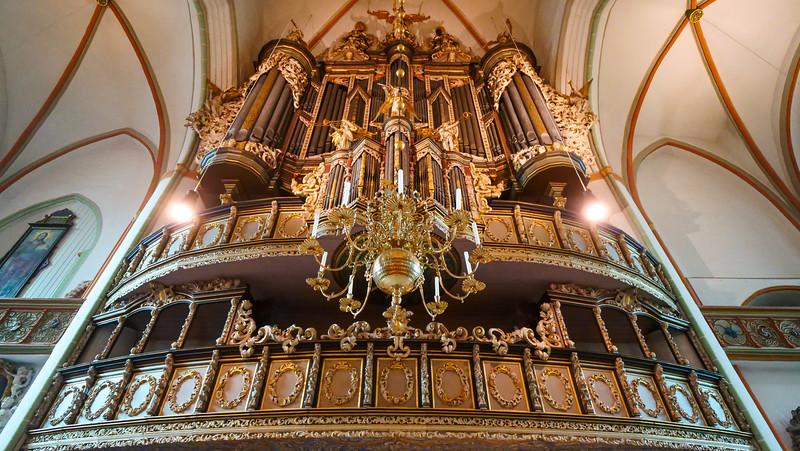
The story goes that when the master builder saw his mistake, he climbed the church tower and threw himself out the window, however, just then, a hay cart went past allowing him to survive the fall. The builder then decided to celebrate the fact that he was still alive with a drink at the pub, and that’s when he fell off a bench and broke his neck.
Is it a true story? Hard to say, but locals love sharing it!
St Michael’s Church
The third church we visited was St Michaelis, or St Michael’s, which was an abbey church of the former monastery of Benedictines.
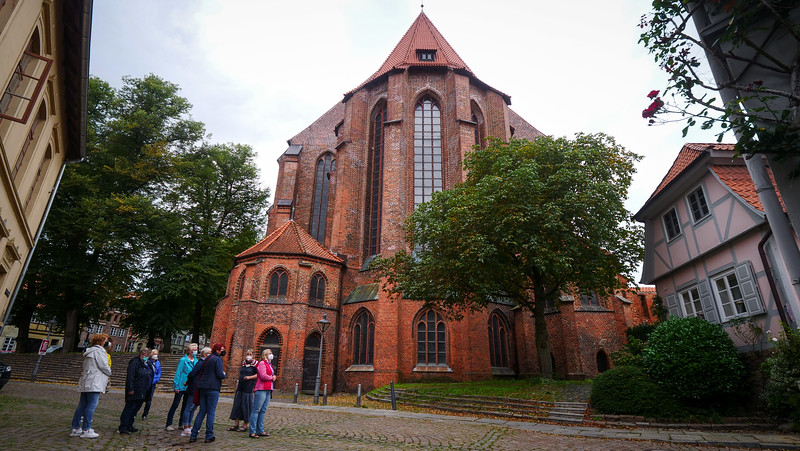

This is where Johann Sebastian Bach was a boarder as a young teenager. Here, he was a singer in the church choir and likely also contributed as an organist.
And because we’ve been talking so much about crooked buildings, I’ll also mention that in this church there’s a plumb line that hangs to the west of the nave, where you can see that the columns aren’t quite straight!
Stroll along the Ilmenau River
During our visit to Lüneburg, we enjoyed a walk along the banks of the Ilmenau River which flows through the town.
This is a really picturesque area and if you’re looking for postcard-perfect photo ops, this is where you’ll find them. You have the weeping willows swaying next to the river, you can see buildings in a variety of architectural styles all standing next to each other, and the bridge is covered in love locks.
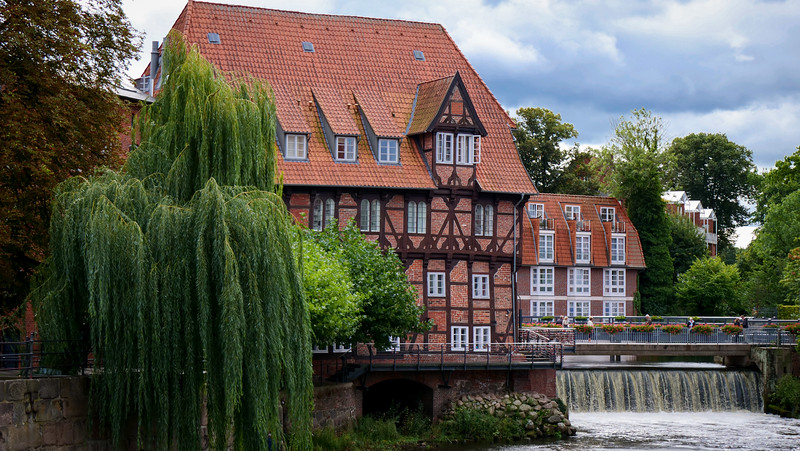

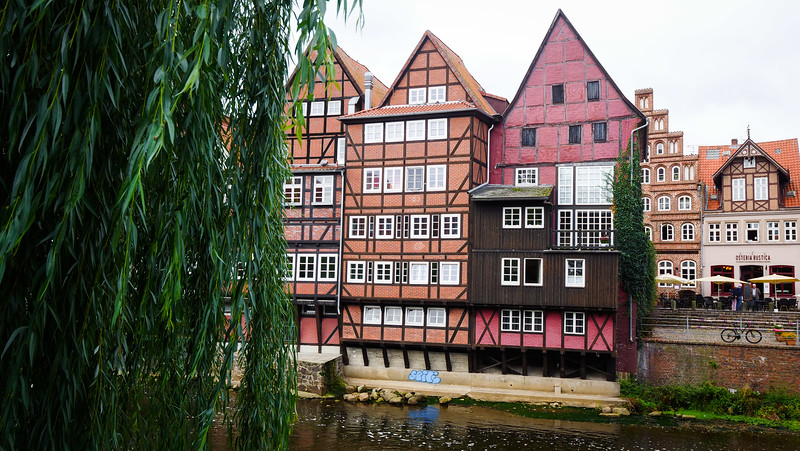
There’s also a nice multi-level terrace on the west bank of the river just across from the medieval crane, and you can find lots of restaurants with outdoor dining.
See the old medieval crane
Another cool attraction to visit in Lüneburg is the old wooden crane, which was first mentioned in documents in the year 1330. This crane was mainly used for the transport of salt and salted herring, and although it is not in use today, its current state is still operational, which is amazing!
![]()
Enjoy lunch with a view
There were so many tempting lunch options, but we ended up settling on Frieda’s am Wasserturm. This restaurant sits right next to the water tower, so it has a pretty cool view, especially if you opt for al fresco dining.

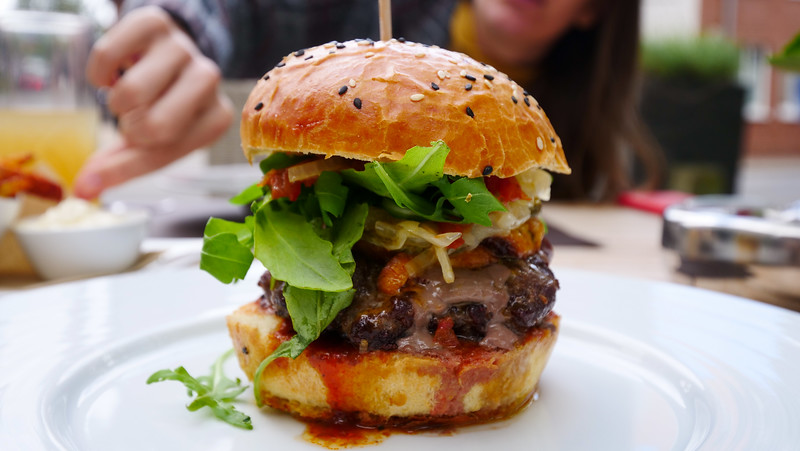
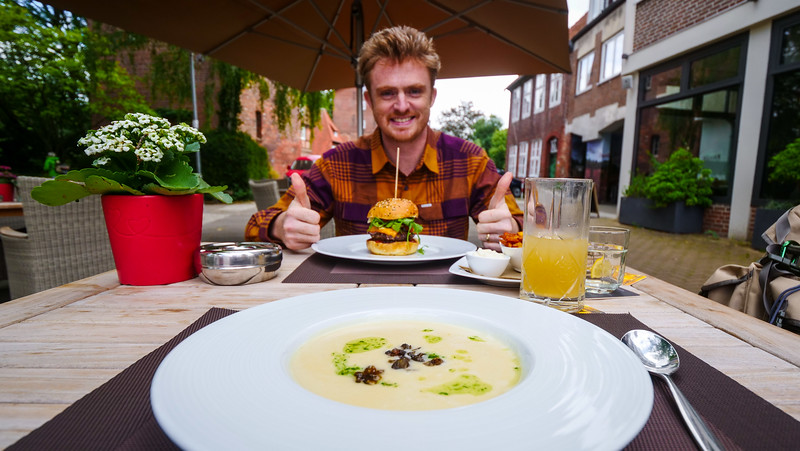
I ordered their parmesan and pesto cream soup, which was delicious and perfect for an outdoor autumn lunch. Meanwhile, Sam opted for their massive hamburger and spicy fries. It was a good meal!
Take a guided tour of the town
One of the best things to do in Lüneburg, in my opinion, is to join a guided walking tour. It’s such a great way to learn about the town’s unique history and its special relationship with salt.
One of the first stops we made during the tour was the building known as the pregnant house due to its bulging belly. This occurred because the walls were built using plaster that contained a large amount of calcium. Because the bricks were fired for too long, they absorbed and accumulated moisture, resulting in the walls expanding outwards.
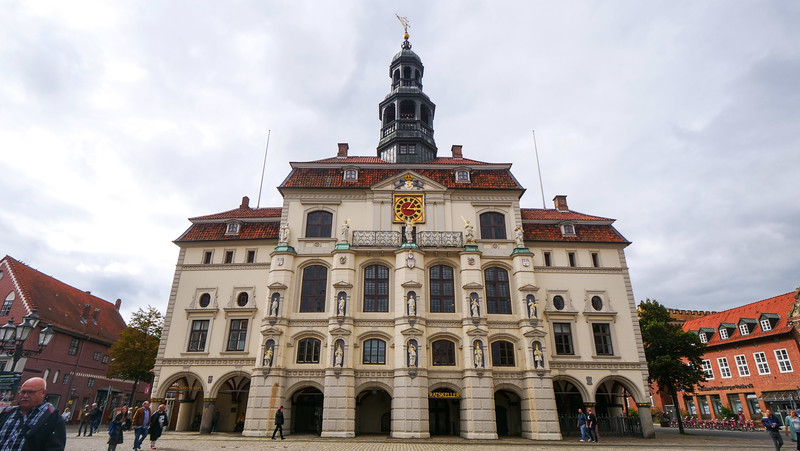
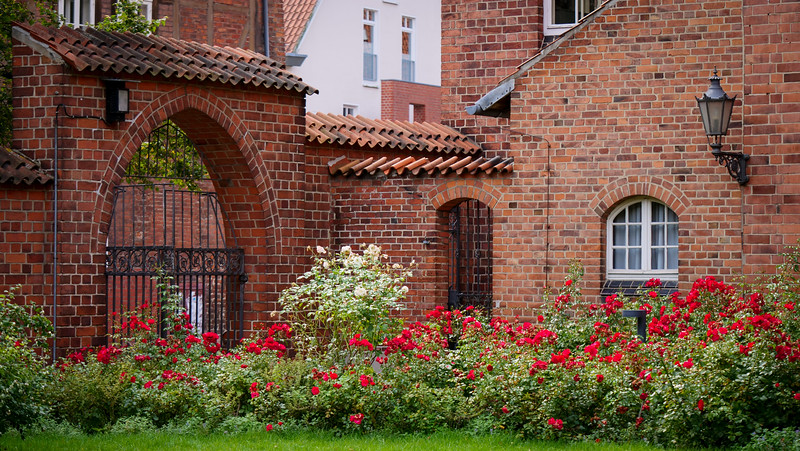
We also visited the town hall building which came into being over the course of several centuries and therefore comprises an eclectic mix of architectural styles which range from North German Brick Gothic to Baroque. This is the largest medieval town hall in Northern Germany and it also has a beautiful rose garden out back.
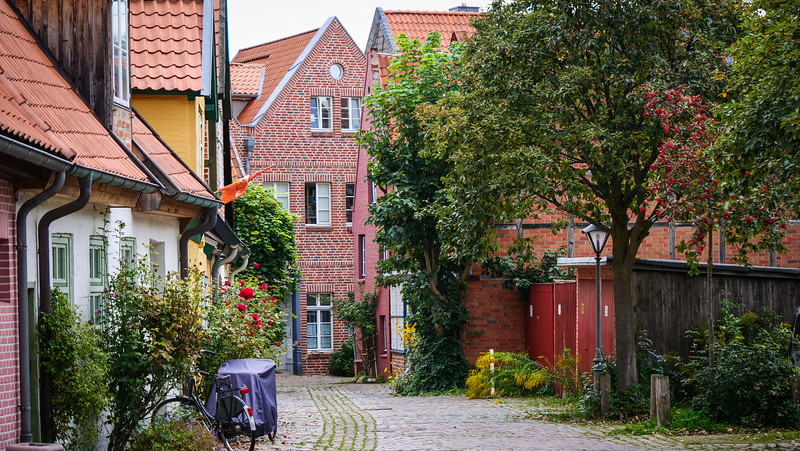
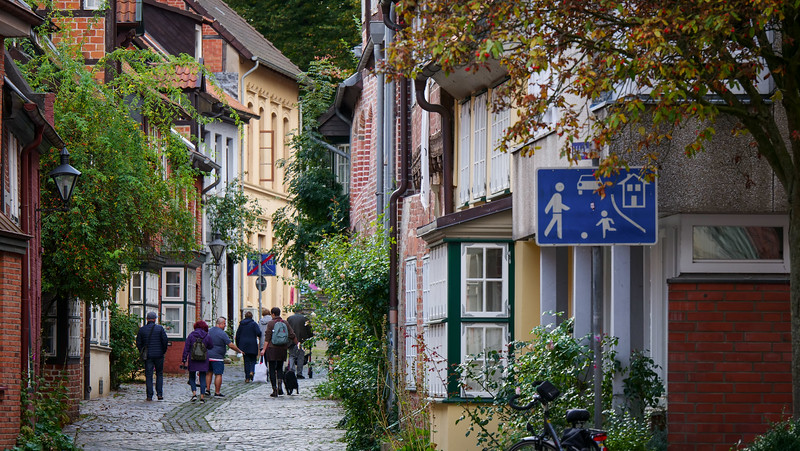
We also learned how in the Middle Ages, Lüneburg found its wealth through salt during a time when table salt was almost as valuable as gold. The problem is that the salt was underneath the town and water was pumped down to extract it creating cavities. This resulted in parts of the town sinking and it’s something that continues to happen to this day. You can see this as you walk past medieval houses that aren’t quite level and whose doorways and windows are slanted.
Visit a chocolate shop
Another place we visited during our day trip to Lüneburg was Schokothek. This is a chocolate shop that carries a wide variety of hand-selected chocolates from across the globe.
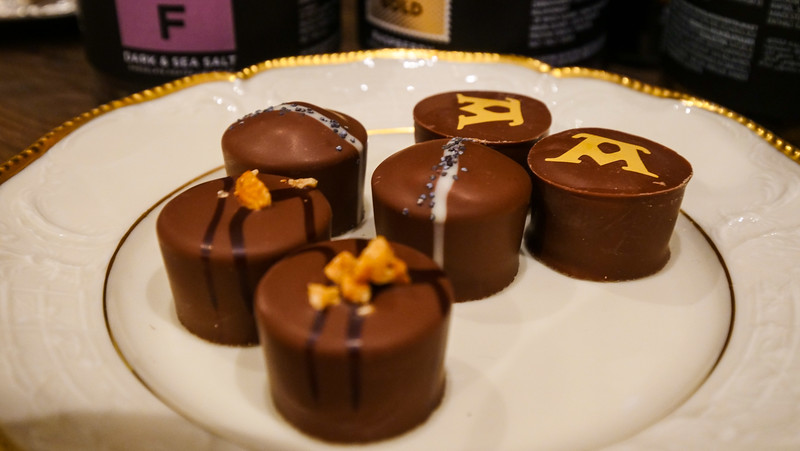
We did a little tasting and also bought some chocolates to take home as gifts. Some of the highlights included the salted caramel chocolate, pistachio and nougat, and then black liquorice for Sam. If you’ve been watching our YouTube channel for a while, you know full well about his salted liquorice obsession! And we also bought a bottle of Franconian wine to take back home as a gift.
Visit the German Salt Museum
We’ve been talking about Lüneburg’s connection to salt and another place to add to the list and learn even more about the subject is the German Salt Museum.
Housed in the historic saltworks of Lüneburg, the museum offers an in-depth exploration of the process of salt extraction and production, which has been an integral part of the town’s history for over a thousand years.
Visitors can learn about the various techniques used in salt production, the daily lives of the workers, and the wider historical context in which the salt trade flourished. The museum recounts how salt, often referred to as “white gold,” was a valuable commodity that significantly influenced trade and economic power in Europe.
The exhibits include original equipment and tools used in the salt-making process, interactive displays, and informative panels. One of the highlights of the museum is the opportunity to see parts of the original saltworks, including the brine wells and evaporation pans.
If you’re a history enthusiast or you’re interested in industrial heritage, then you’ll probably enjoy the German Salt Museum.
Enjoy some hearty dishes
Lastly, we ended our day at Krone with some hearty German pub fare and beer. Also, this place has over 500 years of history!
During the time of the Hanseatic League there were 80 breweries in Lüneburg, and the Lüneburg Kronen Brewery which dates back to 1485 was the only one that remained in existence until it closed in 2001.
While they may no longer brew on-site, today, you can enjoy the restaurant and also visit their brewery museum.

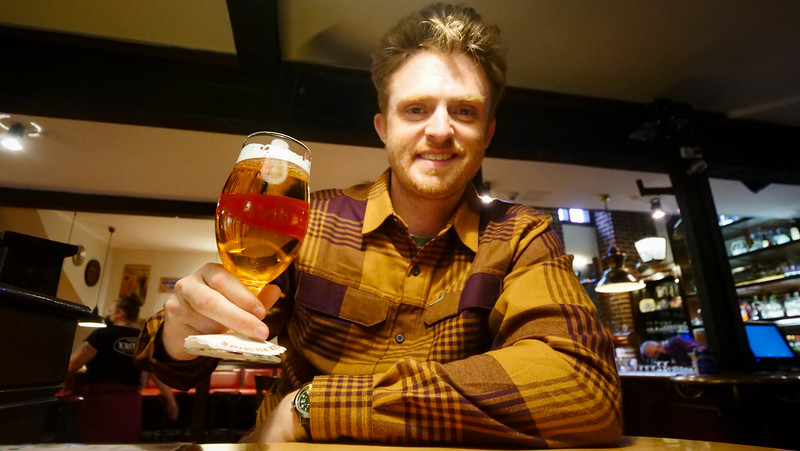
As for the food, we had two of our favourite dishes of the whole trip! Sam got these savoury potato pancakes covered in a chicken and mushroom gravy, while I got the baked potato with sour cream, pickled herring and apples. Simple, classic, hearty German pub food!
How to Have the Perfect Day in Lüneburg: Tips & Experiences
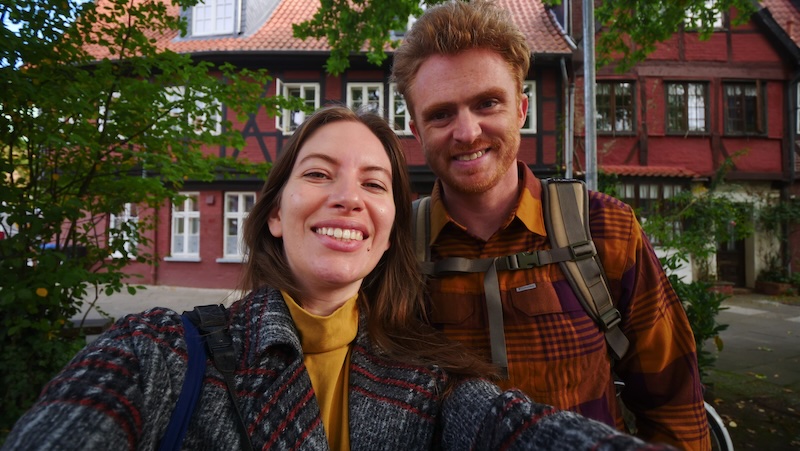
Get Oriented: Arriving, Moving Around & Planning Your Visit
Arriving by Train:
Most travelers arrive via the regional express from Hamburg or the ICE from Hanover, both of which are scenic and easy. The train station is just a short 10–15 minute walk to the Old Town. You’ll pass through leafy neighborhoods that give you an instant taste of local life.
Walking is Best:
Lüneburg’s Old Town is compact and largely pedestrianized, so you can comfortably explore all the highlights on foot. If you’re staying longer or want to explore further, rent a bike from one of the local shops—Lüneburg is wonderfully bike-friendly, with plenty of paths along the Ilmenau River and beyond.
Tip:
Wear comfy shoes—the medieval cobblestones can be hard on your feet, especially if you spend hours meandering the backstreets.
Dig Into the Salt Story: Lüneburg’s ‘White Gold’
By now you know salt put Lüneburg on the map. But the story is everywhere you look. Here’s how to make it come alive on your visit:
- Salt Sights:
Aside from the German Salt Museum (a must for history buffs), keep your eyes peeled for subtle nods to the town’s heritage: look for salt barrels carved into stone facades, salt-themed street art, or salt merchants depicted in stained glass and old murals. - Salt in the Food:
Many restaurants and bakeries in town feature salty specialities. If you want to try a unique treat, order the Salzstange (salt stick), a chewy, salty breadstick that pairs perfectly with Lüneburg’s excellent cheese and sausage. Some local delis even sell salt harvested from the traditional methods still in use today. - Salt Souvenirs:
For a quirky memento, buy a small bag of Lüneburg salt (often attractively packaged) at the museum or town shops. It’s an authentic gift with a story!
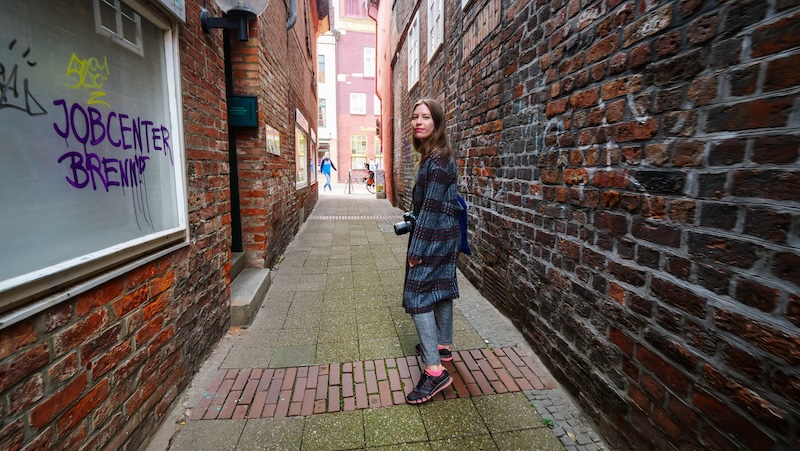
Hidden Gems & Off-the-Beaten-Path Corners
If you want to escape the crowds and see another side of Lüneburg, try these less obvious stops:
- Am Sande’s Secret Cafés:
This lively square is a popular gathering place, but duck down a side street to find independent coffee shops and bakeries. Try a slice of Franzbrötchen (a sweet, cinnamon-laced pastry popular in Northern Germany) and savor some people-watching. - The Lösegraben Canal Walk:
Just beyond the Ilmenau, the Lösegraben is a tranquil canal with leafy pathways, swans gliding past, and bridges that are perfect for an afternoon stroll. In summer, you’ll see locals picnicking or even canoeing here. - Heinrich-Heine-Haus:
Literature lovers should pop into this small museum and cultural venue dedicated to the poet Heinrich Heine, who was born in Düsseldorf but had family roots in Lüneburg. The exhibitions are small but insightful, and the house itself is a lovely example of the town’s historic architecture. - The Brewery Museum:
Since you learned about the Krone brewery’s history, why not pop into the adjoining museum before dinner? It gives a fascinating look at the role beer played in Lüneburg’s daily life, especially in the Hanseatic era.

Lüneburg for Foodies: More Local Eats and Where to Find Them
Market Days:
If you’re in Lüneburg on a Wednesday or Saturday, the market on Am Sande is a must-visit. Sample locally-grown apples, honey, smoked fish, and regional cheeses. You can easily piece together a picnic to enjoy by the river.
Sweet Treats:
Lüneburg is known for Rote Grütze, a tangy red berry pudding often served with cream or vanilla sauce. Look for it at traditional German restaurants or dessert cafes.
Craft Beer:
Aside from Krone, check out Lüneburger Pilsener and other regional brews at local pubs. Beer culture here is alive and well, with many places offering seasonal specialties.
Vegan & Veggie Options:
You’ll find plenty of modern eateries catering to all diets. For a quick lunch, try a falafel wrap or fresh salad from one of the international spots around the university quarter, which is just east of the Old Town.
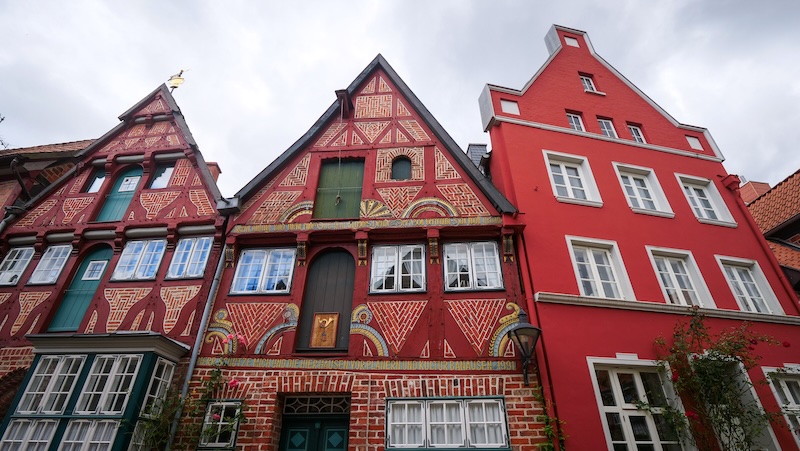
🗓️ One‑Day, Two‑Day & Long‑Weekend Game Plans
| Time in Town | Morning | Mid‑Day | Late Afternoon | Evening |
|---|---|---|---|---|
| Hit‑n‑Run (6 hrs) | 09:00 – Climb the Wasserturm right at opening (elevator up, stairway down). 09:45 – Stroll Platz am Sande while bakeries still have Franzbrötchen warm. | 11:00 – 40‑min guided salt‑mine walk at German Salt Museum. 12:30 – Lunch on the riverside terrace opposite the medieval crane; order a Rote Grütze dessert. | 14:00 – Self‑guided church trio (St Nikolai, St Johann, St Michael). | 16:00 – Craft beer paddle at Krone before your 17:19 RE train back to Hamburg. |
| Leisurely 24 hrs | All of the above, but linger in the stair‑streets behind St Johann for half‑timbered photo ops. | 13:30 – Rent a kayak at Bootsverleih Schröders (€10/hr) and paddle the Ilmenau canal loop. | 16:00 – Coffee & cake at Anna’s Café (bienenstich mandatory). | 19:00 – Sundowner atop L&Ubar (rooftop of Hotel Bergström), then schnitzel night at Mälzer Brauhaus. |
| Slow‑Travel Weekend | Day 1: Above + Friday night jazz at Heiligengeist‑Hospital. Day 2: Bus #5007 to Lüneburger Heide heathlands for the purple heather bloom (Aug‑Sep) or winter sledding on Wilseder Berg; back in town for thermal soak at Salü Salztherme. |
📸 Photo Ops You’ll Kick Yourself for Missing
- Am Stintmarkt at blue hour – fachwerk facades reflecting perfectly in the still canal.
- “Pregnant House” (Schwangere Haus, Waagestraße 8) – use a 24 mm lens and crouch low to exaggerate the bulge.
- Water tower interior – adjust ISO to 1600, expose for the cobalt‑lit tank.
- Heinrich Heine House courtyard – ivy‑draped brick plus wrought‑iron staircase, best lit mid‑morning.
- Salzwerke night steam – in winter the saltworks pipes glow against frosty air (tripod essential).
🚂 Tickets, Transport & Timing Tips
- Regional day ticket (Schleswig‑Holstein Ticket) – €29 + €4 per extra traveller up to 5 people; valid from 9:00 AM weekdays / all‑day weekends on RE/S-Bahn. Perfect if you’re basing in Hamburg.
- Bicycle aboard – RE trains allow bikes (€6 day supplement); Lüneburg station has lockers if you’d rather rent locally (€12/day behind track 4).
- Bus network – StadtBus routes 5001‑5018 cover suburbs and the Heide; buy a 24‑Hour Tageskarte (€4.90) from the driver.
- Lüneburg Card – €10 for 24 h. Includes Wasserturm entry, Salt Museum, and 20 % off selected cafés. Pays for itself if you tick both attractions.
- Avoid Mondays – many museums shut or open half‑days. Tuesday–Sunday gives you full access.

🛌 If You Decide to Stay the Night
| Style | Name & Vibe | Price/Night | Perks |
|---|---|---|---|
| Boutique Charmer | Anno 1433 Hotel am Wassergarten | €115‑135 dbl | Beamed ceilings, breakfast in cloistered courtyard. |
| Budget Chic | B&B Hotel Lüneburg | €69‑79 dbl | 5‑min walk from station; code‑entry so late check‑ins are stress‑free. |
| Self‑Catering | Salz & mehr Apartments | from €95 studio | Kitchens, washer, and a view of St Johann steeple. |
| Countryside | Heide‑Hotel Reinstorf (12 km) | €110‑130 dbl | Spa, free shuttle from station, perfect if combining Heide hiking next day. |
🎉 Annual Events Worth Targeting
| Month | Event | What Happens |
|---|---|---|
| February | Lüneburger Sülfmeistertage | Locals dress as medieval “salt masters”, stage barrel‑rolling races and torchlit river parade. |
| May | Hansetag | Hanseatic city fair: tall‑ship visits, open‑air concerts, 14th‑century trade role‑play for kids. |
| Late Aug – mid‑Sep | Lüneburger Heideblüte | Fields of purple heather; town hosts photography workshops and honey‑tasting walks. |
| December | Historischer Christmarkt | Christmas market in the cloisters of St Michael’s—strictly pre‑1700s crafts, mulled salt‑caramel punch (!). |
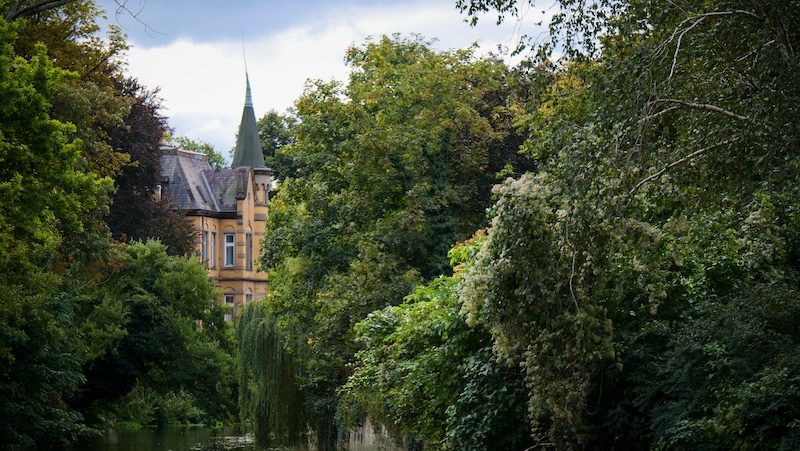
💡 Rapid Fire Info
- Is the town wheelchair‑friendly?
Cobblestones everywhere, but main squares, museums and Wasserturm have ramps/lifts. Side‑streets can be tricky—bring sturdy tyres. - Kid‑friendly?
Absolutely. The Salt Museum runs “Junior Brine‑Boiler” experiments, and the riverside has a pirate‑ship playground. - Cash or card?
Germany loves EC‑Karte but most cafés now take Visa/MC. Farmers’ market and bus tickets still prefer coins – carry €20 in small change. - Good rainy‑day back‑up?
- Prince‑Bishop’s Palace Museum (Baroque interiors + dinosaur fossils)
- Cinema Scala Programmkino (English‑language arthouse films Wednesday nights)
- Two‑hour chocolate workshop at Schokothek (book online).
Lüneburg Day Trip: 12-Question FAQ
How long do I need for Lüneburg?
A full day trip (6–8 hours) comfortably covers the Water Tower, Old Town squares, riverside, the medieval crane, one or two churches, and the German Salt Museum. With 2 days, add guided tours, more churches, and slow café time.
What’s the easiest way to get there?
Train. It’s about 36 minutes from Hamburg Hbf on the RE and roughly 1 hour from Hanover on the ICE. The station is an easy 10–15-minute walk to the Old Town.
Where do I get the best views?
The Wasserturm (Water Tower) has a lift to a panoramic deck and a fun stair descent through the illuminated historic water tank. Rooftops, steeples, and red-brick gables as far as you can see.
Why are some buildings crooked?
Centuries of salt extraction beneath the town created underground voids; parts of Lüneburg slowly subsided, leaving doorframes and facades charmingly askew. Look for the “pregnant house” and the plumb line inside St. Michael’s.
What are the can’t-miss sights for one day?
Platz am Sande, Wasserturm, Stintmarkt by the Ilmenau River, the medieval crane, at least one major church (St. Johann, St. Nikolai, or St. Michael), and the German Salt Museum.
Is there a good guided tour?
Yes—walking tours run most days (often with English options). They unpack salt history, Hanseatic trade, and architectural quirks, and they’ll point out details you’d miss alone.
What should I eat or drink that’s local?
Hearty north German pub fare (try potato pancakes, schnitzel, or baked potatoes with herring), Rote Grütze for dessert, and a Krone or regional pils at a traditional tavern. Bakeries sell Franzbrötchen (cinnamon pastry) in the morning.
Any sweet souvenir ideas?
A small bag of Lüneburg salt, salt-themed chocolates, or local honey/berry products from market days (typically Wed & Sat) on or near Am Sande.
Is Lüneburg kid-friendly?
Very. Compact streets, riverfront playgrounds near Stintmarkt, hands-on bits at the Salt Museum, and towers/steeples to “collect.”
How accessible is the Old Town?
Main plazas, museums, and the Water Tower (lift) are accessible; cobblestones and some side lanes can be bumpy. Churches vary—look for side ramps/doors. Wear supportive shoes.
Cash or card?
Cards are widely accepted, but carry some coins and small notes for markets, bus tickets, church donations, and public toilets.
What if it rains?
Great backups: the German Salt Museum, Town Hall interiors (when open on tours), small galleries, a cozy Programmkino (art cinema) night, or café-hopping with cake.
And that’s a wrap of our day trip to Lüneburg. Hopefully, this travel guide gave you a few ideas of things you can do in Lüneburg on your own visit! And last but not least, we’ll leave you with a video of our visit. Tschüss!

Looks lovely! I’m ready to travel to Europe and back to Germany. We lived there 6 years and loved every drive and medieval town.